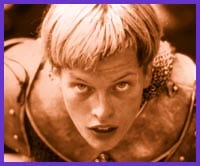Joan of Arc has been reclaimed in France by both lesbians and
the country’s neo-nazi alliance as patron saint of their respective crusades for the 21st century.
“It only makes sense to see Joan as a dyke,” says Nina Ninouska, a history grad student at the Sorbonne University in Paris who’s writing her thesis on Joan of Arc in art and film. “The tomboy persona, the sword of freedom, the armour, her spirit of independence, the fact that she’s totally autonomous without the help of men… it all adds up.”
The leader of the rightwing political party Front National, Jean-Marie Le Pen, has a different spin on France’s national military hero and on the legacy of her 16th century campaign.
“French history and Joan of Arc teach us that people rise up against
oppression,” Le Pen wrote in a widely published editorial this past
Christmas. “In the immensity of the universe offered to us by God,
the battle for family values and a more pure national France is a
battle we cannot lose.”
While Saint Joan fought the invading English and Burgundians in the Hundred Years War, Le Pen’s Front National has widened Joan’s roster of enemies to include “foreigners” of any shade or religion, as well as gay rights activists. In December 1999, le Front National led a public mass in Paris invoking Saint Joan as “celle qui purifie le pays” – “she who purifies the country.”
“That party [Front National] has totally the wrong idea about Saint Joan,” says Paris activist Claudine Olivier.
Olivier is a recruitment and outreach secretary for Davide et Jonathan, a group for gay and lesbian Christians (the two men in the Book Of Samuel are sometimes portrayed as lovers). According to Olivier, the “right idea” was found at the 1999 Gay Pride Parade in Paris. A huge papier mâché statue of La Pucelle (Saint Joan in her famous incarnation as the Maiden of Orleans) was carried alongside a bust of celebrated French dyke novelist Colette.
“The Joan of Arc statue was really about saying to people: there are gays in your church, gays in your history, even gays that your family has adored since forever, like Saint Joan,” Olivier says.
Subversive interpretations of Saint Joan are nothing new. As early as the 1920s, US scholar Dr Margaret Murray interpreted Joan of Arc as a radical earth-worshipping pagan in her study “The Witch-cult in Western Europe.” In her ’70s book The Spiral Dance, Wiccan priestess Starhawk linked the cult of the warrior-saint Joan to the cult of the hunter-goddess Artemis on Lesbos (the island where the poet Sappho gathered her lovers). And today, Joan of Arc web site director Kevin Hendryx reports a popular connection between Joan and the greatest dyke icon of TV: “I will no longer answer the question of who is mightier, Joan or Xena” (it’s at www.godecookery.com),
“Obviously we have no historical proof that Joan was a lesbian any more than that she was straight, or a virgin, or a witch, or whatever,” Ninouska concedes. “But what matters is how we imagine Joan, how we see her and represent her today.”
Ninouska even sees lesbian undertones in supermodel Milla Jovovich’s portrayal of Joan in the 1999 movie The Messenger: “The way she rejects men as lovers throughout the film speaks volumes. Plus, she looks great with short hair.”

 Why you can trust Xtra
Why you can trust Xtra


